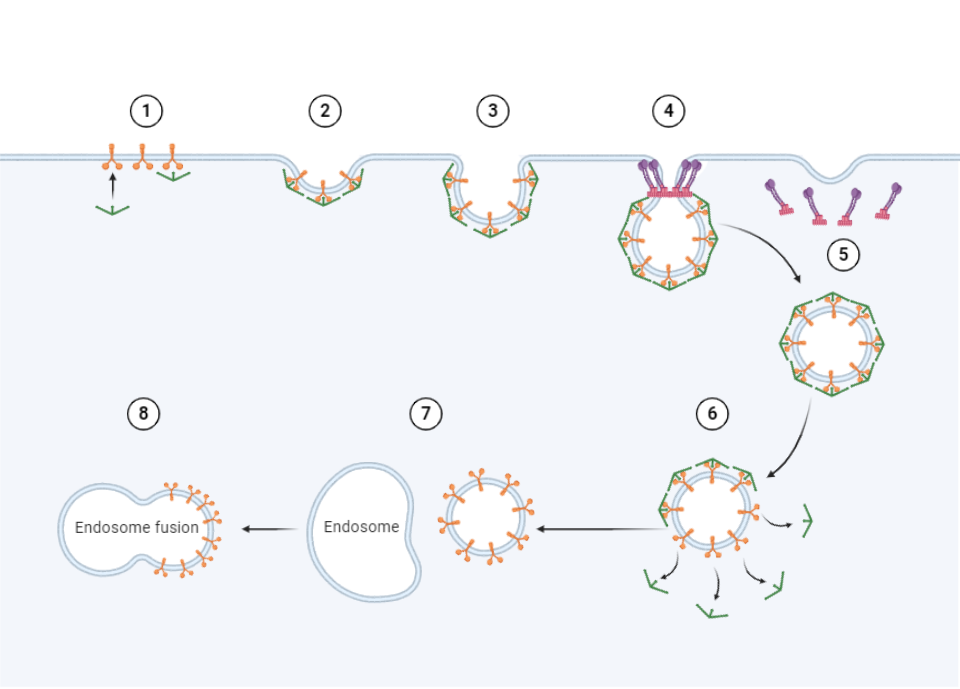Receptor Mediated Endocytosis

Receptor-mediated endocytosis (RME) is a highly regulated and selective process by which cells internalize molecules from their external environment. This mechanism allows cells to take in specific substances, such as nutrients, hormones, and growth factors, while excluding others. RME plays a crucial role in various cellular functions, including signal transduction, nutrient uptake, and immune response. The process involves the binding of ligands to specific receptors on the cell surface, which triggers a series of events leading to the formation of vesicles that internalize the ligand-receptor complex.
The RME process is initiated when a ligand binds to its corresponding receptor on the cell surface. This binding event triggers a conformational change in the receptor, which recruits adaptor proteins and other molecules necessary for the formation of a clathrin-coated pit. The clathrin-coated pit then invaginates into the cell membrane, forming a clathrin-coated vesicle that contains the ligand-receptor complex. The clathrin coat is subsequently removed, and the vesicle fuses with early endosomes, where the ligand is sorted and either recycled back to the cell surface or transported to late endosomes and lysosomes for degradation.
Key Points
- Receptor-mediated endocytosis is a selective process that allows cells to internalize specific molecules from their external environment.
- The process involves the binding of ligands to specific receptors on the cell surface, triggering a series of events leading to the formation of vesicles that internalize the ligand-receptor complex.
- RME plays a crucial role in various cellular functions, including signal transduction, nutrient uptake, and immune response.
- The RME process is regulated by a complex interplay of molecular mechanisms, including receptor binding, adaptor protein recruitment, and clathrin coat formation.
- Dysregulation of RME has been implicated in various diseases, including cancer, neurological disorders, and infectious diseases.
Molecular Mechanisms of Receptor-Mediated Endocytosis

The molecular mechanisms underlying RME are complex and involve the coordinated action of multiple proteins and lipids. The process can be divided into several stages, including receptor binding, adaptor protein recruitment, clathrin coat formation, and vesicle internalization. Each stage is regulated by specific molecular interactions and is influenced by various cellular factors, including receptor density, ligand concentration, and membrane lipid composition.
Receptor Binding and Adaptor Protein Recruitment
The initial step in RME involves the binding of a ligand to its corresponding receptor on the cell surface. This binding event triggers a conformational change in the receptor, which exposes specific binding sites for adaptor proteins. Adaptor proteins, such as AP-2, recognize and bind to the receptor, initiating the formation of a clathrin-coated pit. The recruitment of adaptor proteins is a critical step in RME, as it links the receptor-ligand complex to the clathrin coat machinery.
| Receptor Type | Ligand | Adaptor Protein |
|---|---|---|
| LDL receptor | LDL cholesterol | AP-2 |
| EGF receptor | Epidermal growth factor | AP-2, Grb2 |
| Transferrin receptor | Transferrin | AP-2, AP-1 |

Regulation of Receptor-Mediated Endocytosis

RME is regulated by a complex interplay of molecular mechanisms, including receptor binding, adaptor protein recruitment, and clathrin coat formation. The process is also influenced by various cellular factors, including receptor density, ligand concentration, and membrane lipid composition. Additionally, RME is subject to regulation by various signaling pathways, including those mediated by protein kinases and phosphatases.
Signaling Pathways and Regulation of RME
Signaling pathways play a critical role in regulating RME, as they can modulate the activity of receptors, adaptor proteins, and other molecules involved in the process. For example, the activation of protein kinase C (PKC) can phosphorylate and activate the AP-2 adaptor protein, enhancing the internalization of the ligand-receptor complex. Conversely, the activation of protein phosphatase 2A (PP2A) can dephosphorylate and inactivate AP-2, inhibiting RME.
The regulation of RME by signaling pathways is critical for maintaining cellular homeostasis and responding to environmental changes. Dysregulation of RME has been implicated in various diseases, including cancer, neurological disorders, and infectious diseases. Therefore, understanding the molecular mechanisms and regulation of RME is essential for developing therapeutic strategies to treat these diseases.
What is the primary function of receptor-mediated endocytosis?
+The primary function of receptor-mediated endocytosis is to internalize specific molecules from the external environment, allowing cells to regulate various cellular processes, including signal transduction, nutrient uptake, and immune response.
What are the key molecular mechanisms involved in receptor-mediated endocytosis?
+The key molecular mechanisms involved in receptor-mediated endocytosis include receptor binding, adaptor protein recruitment, clathrin coat formation, and vesicle internalization. These mechanisms are regulated by a complex interplay of molecular interactions and cellular factors.
What are the consequences of dysregulation of receptor-mediated endocytosis?
+Dysregulation of receptor-mediated endocytosis has been implicated in various diseases, including cancer, neurological disorders, and infectious diseases. Understanding the molecular mechanisms and regulation of RME is essential for developing therapeutic strategies to treat these diseases.



